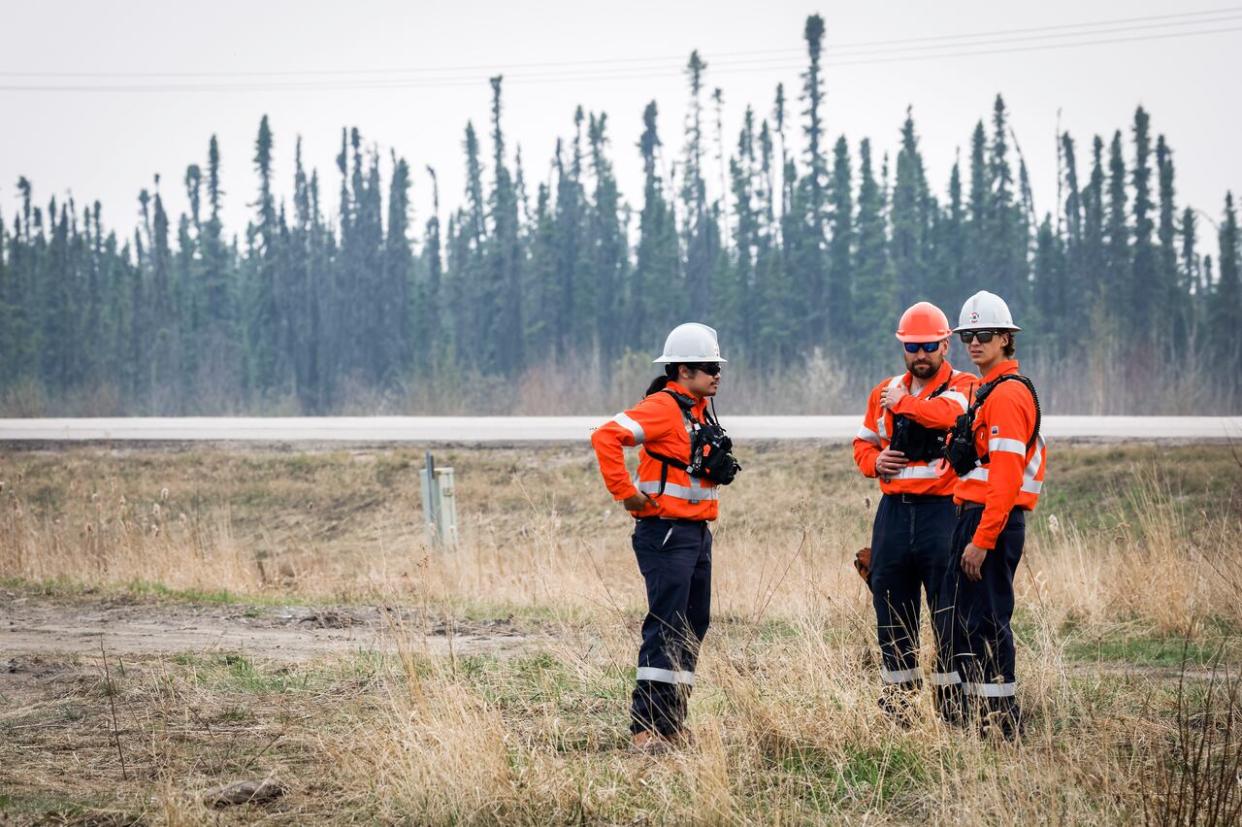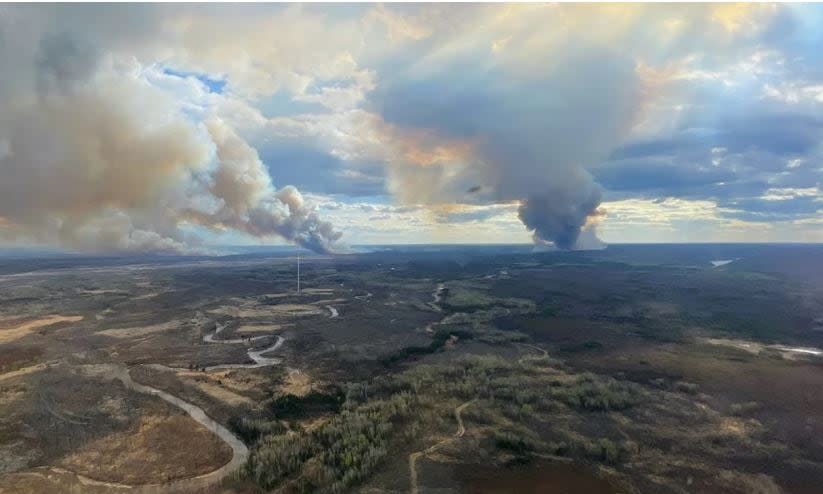Fire threatening Fort McMurray could burn for weeks, maybe months

- Oops!Something went wrong.Please try again later.
Poor internet connection? Access a low-bandwidth, accessible version of this story on CBC Lite.
Cooler temperatures, calmer winds and rain have subdued the wildfire threatening the northern Alberta community of Fort McMurray, giving firefighters time to shore up critical defences in what will be a prolonged battle.
A welcome change in the weather has slowed the fire's approach toward the community but the flames, burning deep underground in the peat-filled muskeg, will not be easily extinguished, a Wildfire Alberta official said Thursday.
"Having the entire wildfire extinguished could take something closer to months, and in some cases, it's taken years," Josee St-Onge said during a news briefing.
"We don't want to speculate, but this is long work and this wildfire will be a reality for weeks and months."
Four neighbourhoods on the southwest edge of the community are vacant, except for fire crews and RCMP patrols. About 6,600 residents were ordered to evacuate Tuesday, when the fire nearly doubled in size, and have been told they shouldn't expect to return home until after the long weekend.
Less than six kilometres
As of Thursday morning, the fire continued to burn out of control along the south side of the Athabasca River valley, less than six kilometres from the outskirts of the community. It is less than five kilometres from the intersection of Highway 63 and Highway 881, the only roads leading south.
A new aerial scan of the fire's size has determined that it has burned 19,820 hectares, which is slightly smaller than had been assessed previously.
The fire didn't grow overnight but has moved slightly north toward the Athabasca River.
St-Onge and government officials urged Albertans to be vigilant about activities that could lead to new fires, as the risk remains extreme.
The majority of wildfires in Alberta are caused by human activity and the province usually contends with a cluster of new wildfires following the May long weekend.
Thursday's forecast calls for winds from the east, an afternoon high of 11 C, and up to 20 millimetres of rain before nightfall. Periods of rain and cooler temperatures are expected to continue through Monday.
Protection efforts
Crews are using the change in the weather to continue efforts to protect the community, including a massive fireguard that stretches from Highway 63 to the banks of the Athabasca River.
The massive trench has been cleared of debris and potential fuels to act as a front line that will slow the fire down if the winds shift and start pushing it back toward the community.
St-Onge said they hope it will hold, unlike one that was breached by flames earlier this week.
"The difference with this fireguard and the one that was established five days ago is that we've had much more time to work on it and we have more equipment and they're working around the clock," she said.
"This fireguard is a lot bigger and a lot stronger."
An evacuation alert remains in place for the remainder of the city and many surrounding communities, with residents on orders to be prepared to leave at a moment's notice.
The neighbourhoods of Prairie Creek, Beacon Hill, Abasand and Grayling Terrace make up the evacuation zone, where firefighters are now at work.
Crews are clearing any debris that might catch a spark and dousing homes and businesses with fire retardant.
Jody Butz, the regional fire chief, said the community remains untouched, with no reports of property damage.
He said RCMP are patrolling evacuation zones and properties will not be damaged by the preventative work being done by fire crews now.
He said it's not clear if the rain will be enough to allow residents back earlier than anticipated but it's providing welcome relief.
"We're graced with Mother Nature's kindness here today. We'll take all the rain we can get."
Soakers, studded with cannons that can blast enough water into fire-threatened ditches to fill an Olympic-sized swimming pool every 90 minutes, are part of the effort.
"The system was designed after 2016," said Derek Sommerville, a wildfire specialist with the Alberta company Fire and Flood Emergency Services.
"We can cover large distances. That frees up traditional mobile resources like fire trucks and helicopters to deal with higher priority areas."
Six kilometres of hoses, powered by 600-horsepower pumps, are an example of how Alberta seems better prepared to face such threats than it was eight years ago.
"They're definitely a little better prepared with the notices that came out," said David Warwick, a resident of one of the evacuated neighbourhoods.

The wildfire threatening Fort McMurray grew rapidly on Monday, fuelled by shifting winds. (Alberta Wildfire)
This is the second time Fort McMurray has been forced to flee the flames. In 2016, destroyed more than 2,000 homes and forced 80,000 out of the city and surrounding area.
Fort McMurray firefighter Mark Stephenson watched his own home burn in 2016. As his wife and children evacuated to safety this week, he remained behind to again fight the flames.
After the 2016 fire, he recovered a few small belongings from the wreckage of his home, including his son's piggy bank. His son took the keepsake with him when he left Fort McMurray with his mother on Tuesday.
Stephenson said knowing that his family is safe helps him focus on the task ahead, one he feels crews are better prepared for this time.
The strength and expertise of the emergency response has increased while the the strength of this fire pales in comparison, he said.
"I'm hopeful that none of our neighbourhoods are going to be touched," he said.

